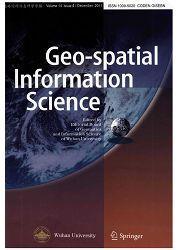Investigation and validation of two all-weather land surface temperature products with in-situ measurements
IF 5.5
1区 地球科学
Q1 REMOTE SENSING
引用次数: 0
Abstract
The need for cross-comparison and validation of all-weather Land Surface Temperature (LST) products has arisen due to the release of multiple such products aimed at providing comprehensive all-weather monitoring capabilities. In this study, we focus on validating two well-established all-weather LST products (i.e. MLST-AS and TRIMS LST) against in-situ measurements obtained from four high-quality LST validation sites: Evora, Gobabeb, KIT-Forest, and Lake Constance. For the land sites, MLST-AS exhibits better accuracy, with RMSEs ranging from 1.6 K to 2.1 K, than TRIMS LST, the RMSEs of which range from 1.9 K to 3.1 K. Because MLST-AS pixels classified as “inland water” are masked out, the validation over Lake Constance is limited to TRIMS LST: it yields a RMSE of 1.6 K. Furthermore, the validation results show that MLST-AS and TRIMS LST exhibit better accuracy under clear-sky conditions than unclear-sky conditions across all sites. Since the accuracy of the all-weather LST products is considerably affected by the input clear-sky LST products, we further compare the all-weather LST with the corresponding input clear-sky LST to conduct an error source analysis. Considering the clear-sky pixels on MLST-AS directly using the estimates from MLST, the error source analysis is limited to examining TRIMS LST and its input (i.e. MODIS LST). The findings indicate that TRIMS LST is highly correlated with MODIS LST. The investigation and validation of the two selected all-weather LST products objectively evaluate their accuracy and stability, which provides important information for applications of these all-weather LST products.两种全天候地面温度实测产品的调查与验证
为了提供全面的全天候监测能力,多种陆地表面温度(LST)产品的发布导致了对全天候陆地表面温度(LST)产品进行交叉比较和验证的需求。在这项研究中,我们重点验证了两种成熟的全天候LST产品(即MLST-AS和TRIMS LST)与四个高质量LST验证站点(Evora, Gobabeb, KIT-Forest和Lake Constance)的原位测量结果。对于陆地站点,MLST-AS的均方根误差在1.6 K ~ 2.1 K之间,而TRIMS的均方根误差在1.9 ~ 3.1 K之间。由于被分类为“内陆水”的MLST-AS像素被掩盖了,因此对康斯坦斯湖的验证仅限于TRIMS LST:它产生的RMSE为1.6 K。此外,验证结果表明,MLST-AS和TRIMS LST在晴空条件下的精度优于非晴空条件。由于全天候LST产品的精度受输入晴空LST产品的影响较大,我们进一步将全天候LST与相应输入晴空LST进行比较,进行误差源分析。考虑到MLST- as上的晴空像元直接使用MLST的估计,误差源分析仅限于检查TRIMS LST及其输入(即MODIS LST)。结果表明,TRIMS的地表温度与MODIS的地表温度高度相关。通过对所选两种全天候LST产品的调查验证,客观评价了其准确性和稳定性,为全天候LST产品的应用提供了重要信息。
本文章由计算机程序翻译,如有差异,请以英文原文为准。
求助全文
约1分钟内获得全文
求助全文
来源期刊

Geo-spatial Information Science
REMOTE SENSING-
CiteScore
10.10
自引率
28.30%
发文量
710
审稿时长
31 weeks
期刊介绍:
Geo-spatial Information Science was founded in 1998 by Wuhan University, and is now published in partnership with Taylor & Francis. The journal publishes high quality research on the application and development of surveying and mapping technology, including photogrammetry, remote sensing, geographical information systems, cartography, engineering surveying, GPS, geodesy, geomatics, geophysics, and other related fields. The journal particularly encourages papers on innovative applications and theories in the fields above, or of an interdisciplinary nature. In addition to serving as a source reference and archive of advancements in these disciplines, Geo-spatial Information Science aims to provide a platform for communication between researchers and professionals concerned with the topics above. The editorial committee of the journal consists of 21 professors and research scientists from different regions and countries, such as America, Germany, Switzerland, Austria, Hong Kong and China.
 求助内容:
求助内容: 应助结果提醒方式:
应助结果提醒方式:


